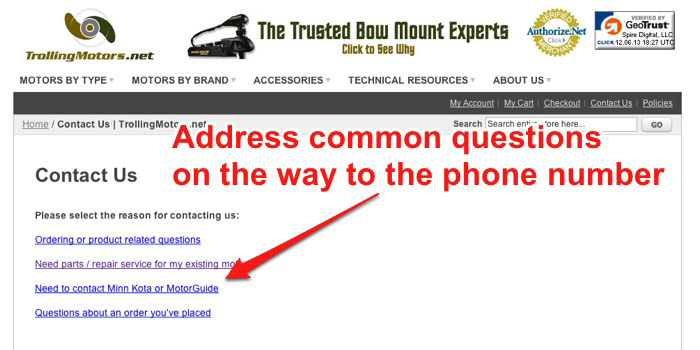
Deciding if and how to offer phone support is one of the hardest things I’ve wrestled with as an eCommerce entrepreneur. I’ve tried half a dozen different approaches and I’m still not 100% satisfied with how I’ve incorporated it in my business. It’s a really tough issue, especially for small independent merchants with limited staff.
Today I want to share the bumpy road I’ve traveled regarding phone support and how I’m approaching it today, and offer tips for how to best incorporate phone support into your own business.
The Benefits of a Phone Number
There are a lot of great advantages to offering quality, personal phone support:
It’s a great way to learn: Especially early on in a new business, there’s no better way to understand your customers than by talking to them directly. You’ll learn all sorts of things about them through casual conversation that would never come up in an email.
Faster service: Few things resolve an issue or get a question answered faster than a phone call. It’s a great customer experience.
Easier to build rapport: Talking directly with a person allows you to build a rapport and then turn a potential lead into a life-long customer.
Builds trust for high-priced items: Selling $4,000 diamond-studded fingernail clippers? You’d better have a phone number! The more expensive the items, the more likely your customers will want to talk to you before pulling the trigger. (Plus, wouldn’t you want to find out who was spending $4K on nail trimmers?)
The Downsides of a Phone Number
But there are plenty of problems as well, especially for bootstrapping entrepreneurs and small teams:
It’s expensive: Providing good phone support is downright expensive (from a staffing perspective), which isn’t necessarily a problem if you have rich margins or high per-order profits. But if you’re selling smaller items, or working with thin margins as a drop shipper, it can be very difficult to offer phone support and still be profitable.
It’s hard to outsource well: How many times have you had an incredible outsourced phone experience? Yeah, me neither. Usually it’s a terrible experience that leaves you thinking less of the company you called. If you’re going to do it right, you’ll need to keep your phone support in-house.
Dealing with low-value calls: If everyone who called asked a few well-thought-out questions and then placed an order, offering phone support would be a no-brainer. The problem is that for every “ideal” phone customer, you’ll field numerous calls that aren’t necessarily a good use of your time. People will call to ask about items you don’t have. They’ll ask dozens of questions and then order from the competition, or they might disable your productivity with a meandering conversation for the better part of an hour.
Requires constant monitoring: If you’re bootstrapping your store alongside your 9-to-5 (well done!), it’s next to impossible to provide real-time phone support. And even if you’re working full-time on your store, chances are you’re wearing a ton of hats and are working on many other tasks. Taking calls throughout the day makes it hard to focus for long periods of time, breaks your concentration and makes it more difficult to be productive.
How I Initially Handled the Phones
When I started my first store, Right Channel, I loudly advertised my phone number and personally answered every call that I received. And it was terrific! I learned a tremendous amount about my customers’ needs and problems, and really grew to understand the market and products. Plus, my customers received top-notch personalized service, which helped build my store’s reputation.
As time wore on, however, I started to reconsider phone support for all of the reasons listed above – especially when I realized that the vast majority of my revenue (85%+) was being generated via orders placed online.
By deciding to stop accepting phone calls, I lost less than 15% of my revenue and freed up a substantial amount of time to market the business and better serve existing customers. It was a classic 80/20 scenario and was a much more scalable model for my then-solo operation.

Phone Support vs. Customer Service
I think it’s crucial to clarify at this point that I believe offering outstanding customer support is absolutely essential for eCommerce success. To many, I imagine this may appear like I’m “gutting” the service department in favor of efficiency, which is definitely not a sustainable long-term business strategy.
But I don’t think customer support can be defined with something as narrow as offering phone support. To me, great customer service means offering a quality product and solving problems quickly for the customers you’ve chosen to do business with.
While I decided not to offer broad in-bound phone support, I was focusing on other areas to make sure I was offering quality support. Things like sending out free replacements for defective items, upgrading packages to express shipment and quickly replying to emails. I was intentionally choosing not to do business with a small segment of my customers (those who needed to call in), but was making sure to offer top-notch support in all other areas of the business.
How I’m Handling Phones Now
Over the years, I’ve tried just about every type of phone situation you can imagine to offer phone support in a cost-effective way. I’ve put a toll-free number on the website that went to voicemail so I could call customers back. I’ve had a toll-free number that went to a voicemail asking customers to email us (which I don’t recommend). I’ve also gone cold-turkey and completely removed the phone number from the site.
After changing things up countless times, here’s what I’m doing today after experimenting for years with our phones:
For Right Channel Radios
At Right Channel, we sell radio equipment and accessories that have a lower average order price. Because the per-order profit is on the small end, we don’t offer a general sales number where customers can call in with questions.
Instead of investing in phone support that isn’t scalable, I’ve invested heavily in creating an extremely detailed website with tutorials, pictures and in-depth product descriptions to help shoppers make informed decisions.
I do, however, have a phone number for business clients, as they’re more likely to order in bulk. And if we have regular customers call us on this business number, we’re happy to help/accomodate them via the phone.
For TrollingMotors.net
TrollingMotors.net is a slightly different beast. Because we sell high-end trolling motors that can cost as much as $2,000, we have a general phone number customers can call. Offering phone support isn’t any less expensive, but the fact that the per-order profit is much higher makes this something we’re able to profitably do.
Additionally, because the items are more expensive, a much larger percentage of customers want to talk with someone before or during purchase. So if we didn’t offer a toll-free number, we’d see a significant portion of our sales dry up.
Limited Phone Hours
For both businesses, our phone lines are open only in the mornings between 8:30 a.m. and 12:30 p.m. MST. After a lot of back and forth, we’ve found this to be a good compromise for offering phone support but not allowing it to consume our entire day. This way, our team can focus on operations in the morning and work on longer-term projects that require more focus in the afternoons without being interrupted.
Who’s Answering the Calls?
For the first few years of business, I personally answered calls for both businesses, so I’m very comfortable doing that. But once I brought on my first state-side employee (here’s looking at you, Pat!), he took over those responsibilities. So while I’ll occasionally cover the phones when he’s out of the office, it’s a trusted team member who manages most of those calls.
Before Pat came on board, I considered hiring a call center to help me but I decided against it – and I’m glad I did. I think it’s extremely difficult to train third-party contractors to provide quality phone support, especially if your needs go beyond basic operational issues (returns, order placement, etc.). Personally, I’d rather have no phone number than offer a subpar outsourced phone experience to my customers.
Tips for Your Own Business
As you’re wrestling with this beast called phone support, here are a few tips from my experience that should help:
Know What Percentage of Sales Come From the Phones
This is absolutely crucial to understand for your business. If only 5% of your revenue comes from the phones, eliminating your toll-free number is probably a no-brainer. But if you’re generating 70% of sales via phone orders, you’ll need to be very careful with the changes you make.
You can, of course, track this manually. But what I prefer to do is to set up two Google Analytics profiles – one that includes ALL of my sales data and one that filters out sales data that originates from our location in Bozeman, Mont.
Because we place most customer orders via the website, all of these “phone orders” will be filtered out of the revenue report in the second profile. Comparing the difference in revenue between the two profiles is a quick way to determine how much of your revenue is being generated by the phone.
Locate Your Number Strategically
Slapping your toll-free number in 80-point font on your homepage probably isn’t the best approach, as you’ll likely be flooded by callers asking any and all random questions. Instead, be a little more strategic to increase the number of high-value calls you get.
At TrollingMotors.net, we were repeatedly getting calls asking about repair parts (which we don’t sell) and from customers inquiring about warranty issues (because they thought we were the manufacturer). So to help increase efficiency, we listed four options on our “Contact Us” page.
If the visitors needed help with one of the issues we didn’t offer, the link they clicked would quickly address that issue and point them in the right direction. If they needed to order – or needed help with an existing order – they’d see a page with our phone number.
Do It Well – Or Not at All
Unless you’re offering a VERY basic product that doesn’t need much explaining, it’s going to be difficult to outsource your phone support. Sure, you can have a call center take orders and pass along return information to you. But if your customers need much more than that, they’re going to be frustrated talking to someone who’s working off a script.
Your best bet? Either skip the phone line all together and provide email support or bring it in house.
Beef Up Your Website and Email Support
If you won’t be offering a phone number, you’ll need to have exceptionally good email support. As someone who used an Excel worksheet to track customer support issues when I got started (I can’t believe I’m admitting this), I’d highly recommend using a help desk. I currently use Zendesk, but I’ve been impressed by HelpScout recently and would recommend them as well.
Without phones, you’ll also need to invest in an incredibly detailed and value-adding website. That’s because most customers will simply go elsewhere if you’re not available to answer questions directly and your website does a poor job of supplying the information needed. For more insights on beefing up your website, see this case study on redesigning an online store.
Which Toll-Free Service to Use?
Currently, we use RingCentral … and they’re all right. Not great, but all right. Their interface is pretty complex and confusing, but once you get things set up, everything seems to work fairly well – unless you’re on a Mac. If you’re an Apple guy, RUN AWAY from RingCentral, as their OS X soft phone is absolutely terrible.
I’ve heard good things about Grasshopper, although I’ve never used them myself, and Phone.com and Phonebooth.com are some other options. My friend and fellow store owner Pete Sveen did a great write-up comparing these four phone services over at Think Entrepreneurship that’s definitely worth checking out.
What Do You Think?
How do you handle phone support in your business? Think I’m missing out by not offering full-fledged phone support? I know there are a ton of opinions on the issue, and I’d love to hear from you in the comments below.
Check out our favorite customer service scenes from movie and film right here!




